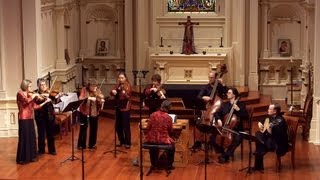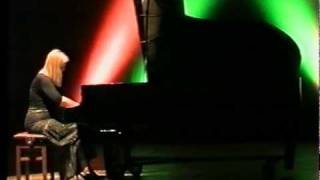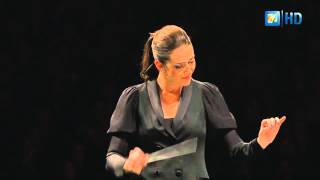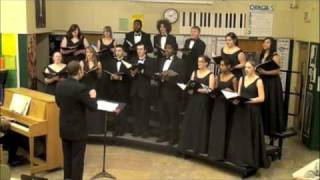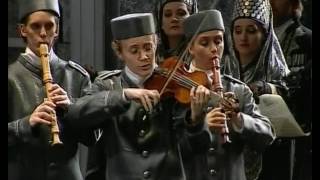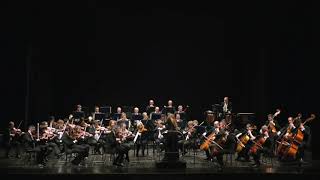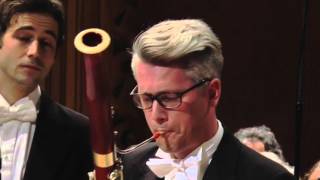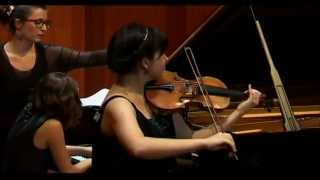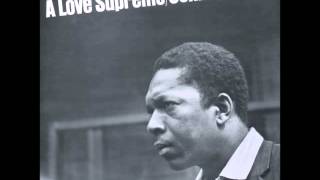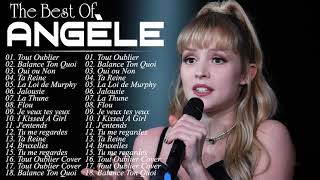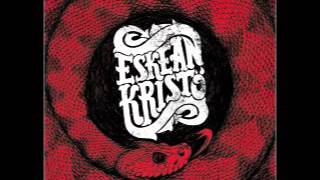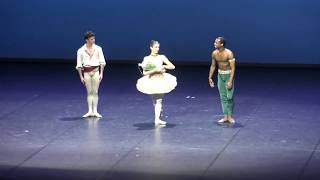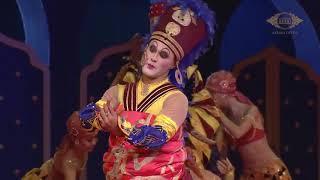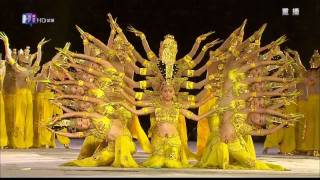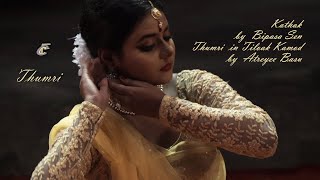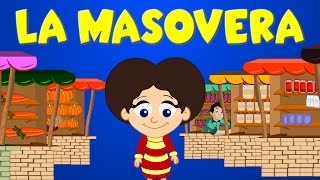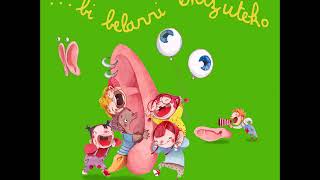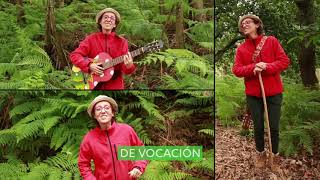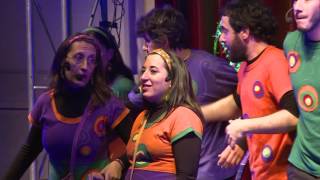Recommended music videos for initiation to classical music
Johann Sebastian Bach (1685-1750) was a German violinist, organist, conductor and composer. He was born in Eisenach into the most prominent musical family in history, with more than 30 famous composers in its midst. In 1703 he obtained his first job as court musician to the Prince of Arndstat and in 1707 he moved to Mülhausen as an organist, where he married his cousin Maria Barbara with whom he had seven children. After the death of his wife in 1720, he remarried Maria Magdalena a year and a half later, with whom he would have another thirteen children. In 1723 he moved to Leipzig, where he would reside until his death at the age of 65. A prolific composer, he is considered one of the three main geniuses in the history of music along with Mozart and Beethoven.
The catalogue of Bach's works or Bach-Werke-Verzeichnis , better known by its initials BWV , consists of a numbered index of all the composer's works arranged thematically by type of work or genre and according to their vocal or instrumental nature and used by scholars and musicians around the world. This catalogue was created in 1950 by the German musicologist Wolfgang Schmieder .
The Suites for Orchestra, BWV 1066–1069 (called ouvertures after their author), are four pieces written by Johann Sebastian Bach between 1725 and 1739 in Leipzig . In a broad sense, the term suite was used in Baroque Germany to refer to a series of dance pieces preceded by an ouverture .
The Orchestral Suite No. 3 in D major , BWV 1068 , is structured in five movements, of which today we offer the second, Air (aria) , which is one of the most famous pieces of Baroque music in a version by the Voices of Music group, the most popular early music ensemble in the USA .
José Antonio Donostia or Aita Donostia , in Spanish Padre Donostia (1886-1956) was a writer, composer, musicologist and organist from San Sebastián, who began his musical studies in 1896 in the town of Lekaroz ( Navarre ). At the age of ten he entered the Lekaroz Seminary as a student. In 1908, after becoming a priest, he expanded his musical training in Barcelona and in the years 1920 and 21 he perfected it in Paris with Eugenio Cools . In 1932 he became a euskaltzain , that is, a member of the Royal Academy of the Basque Language (Euskaltzaindia). As a composer he produced abundant chamber music, organ pieces, numerous choral works, melodies and songs with piano, which brought him well-deserved renown. As a folklorist he collected more than a thousand popular Basque songs.
Oñazez (pain), prelude for piano no. 6 , “reproduces the melody of a traditional folk song of charming beauty and simplicity in its melody. Its harmonization is novel but appropriate to the line. It presents pianistic difficulties alien to traditional virtuosity and, despite finding in it various stylistic influences, it maintains the personal seal of the composer and the profile of Basque folklore” ( Taringa ). Today it is offered to us by the piano professor at the University of San Juan , Argentina, Ana Inés Aguirre.
Arturo Márquez (Sonora, Mexico, 1950) is a Mexican composer known for using Mexican musical forms and styles in his compositions. His family moved to Los Angeles in 1962; three years later, at the age of 16, he began studying violin, tuba, trombone and piano, with which he began his first compositions with an intuitive harmony accompaniment. In 1967 he returned to Navojoa (Sonora) to direct his Municipal Music Band . From 1970 to 1975 he studied piano at the National Conservatory of Mexico and in 1976, composition at the National Institute of Fine Arts ; in 1980, upon completing this workshop, the French government awarded him a scholarship to study in Paris for two years. In 2009 he was awarded the National Prize for Fine Arts of Mexico .
Danzón No. 2 is a musical work for symphony orchestra composed by Arturo Márquez and premiered on March 5, 1994. Influenced by danzón, popular rhythms and Mexican concert music , it is the most notable of the series of nine danzones, and became a recurring piece in the performance of symphony orchestras in Mexico and the world. The Mexican government on its twentieth anniversary recognized Danzón No. 2 as "the second most famous work of Mexican concert music, only behind the Huapango of José Pablo Moncayo ." Critics such as Aurelio Tello describe it as "one of the most profoundly genuine faces of current music."
Today, the Philharmonic Orchestra of the Americas brings us the performance under the direction of Alondra de la Parra (1980), an internationally renowned Mexican conductor who is currently the director of the Queensland Symphony Orchestra and who is the first woman to hold a position in this entity in Australia .
Béla Bartók (1881-1945) was a Hungarian pianist and composer who carried out extensive research into the folklore of his country; he was one of the founders of ethnomusicology . At the age of five he began his musical studies with his mother, a piano teacher; at eleven he gave his first concert with a work by Beethoven and another of his own, composed two years earlier. Shortly afterwards, the family moved to Pozsony, where he met Ernő Dohnányi . Together they moved to Budapest , where he studied composition as well as continuing his piano studies. He met Zoltán Kodály with whom he carried out an in-depth study of Hungarian folklore (he collected thousands of songs from the mouths of peasants), which he applied to his own compositions.
Three Hungarian Folksongs is a collection of folk songs for choir and piano composed by Béla Bartók between 1914 and 1918, during a period when Bartók was deeply fascinated by the folk music of Romania and his native Hungary . The set consists of three short folk tunes: I (0´10´´) The Peacock. ANDANTE TRANQUILLO, RUBATO .-. II (1´32´´) At the Fairgrounds at Janoshida. ALLEGRO NON TROPPO, UN POCO RUBATO .-. III (2´10´´) The White Lily. MAESTOSO
Recommended classical music videos
Georg Friedrich Haendel (1685-1759) was born in Halle , Germany. He became a naturalised Englishman and is one of the greatest figures in the history of music , including the Baroque. As a child he began to receive harmony and counterpoint lessons from Friedrich Zachow , organist in Halle , with whom he also learned to play the oboe, violin and organ. At the age of 18 he moved to Hamburg, where he wrote his first two operas. After three years he travelled to Florence and then to Rome . In 1710 he returned to Germany and from there to London , where he settled for life. Despite the total silence with which he protected his privacy, his homosexuality seems clear. Of his abundant musical production, we must highlight the Oratorio The Messiah , one of the masterpieces of history . He died at his home at the age of 74.
The catalogue of works by Georg Friedrich Händel, known by the acronym HWV , stands for Handel Werke Verzeichnis (in German, Catalogue of Handel's Works). It is not arranged chronologically but thematically, by type of work or genre and according to its vocal or instrumental nature. It covers 612 works plus 25 supplements and doubtful and lost works, and was compiled between 1978 and 1986 in three volumes. The exact number of compositions is therefore difficult to determine. Its author is the musicologist Bernd Baselt .
Xerxes (Serse in the original Italian; HWV 40) is a serious opera in three acts by George Friedrich Handel. It was first performed at the King's Theatre, London on 15 April 1738. The Italian libretto was adapted by an unknown hand from that written by Silvio Stampiglia for an earlier opera of the same name by Giovanni Bononcini in 1694. The opera is set in Persia (present-day Iran) in 480 BC and is based very loosely on Xerxes I of Persia , although there is little in the libretto or music that is relevant to that setting. Serse , originally sung by a castrato soprano, is now usually sung by a soprano (or mezzo-soprano).
The opening aria, " Ombra mai fu ", sung by Xerxes to a plane tree (Platanus orientalis), set to one of Handel 's best-known melodies, is often referred to as Handel's Largo (even though it is written as "larghetto" in the score). Serse is for many the most Mozartian of Handel 's operas. Passion is mixed with farce and satire; human stupidity is exposed but not ridiculed. Today we are witnessing its staging by Les Talens Lyriques, conducted by its founder, the French maestro Christophe Rousset.
Ludwig van Beethoven (1770-1827) was one of the giants of Western music along with Bach and Mozart . Born on 16 December 1770 in Bonn , his father, of Flemish origin, tried to present him as a second Mozart , although it was a notable failure. Despite this, from the age of nine the organist Christian Gottlob Neefe captivated him with the study of Bach , whom he would always keep in mind. In 1787 he moved to Vienna with the intention of receiving classes from Mozart , but the death of his mother brought him back to Bonn a few days later. And so after five years, he returned to Vienna where he was able to study with Haydn and Salieri . However, his profession as an excellent pianist could not be realized due to the deafness that attacked him the following year, leaving him totally incapacitated in this faculty.
The catalogue of Beethoven's works . There are 138 musical works composed by Beethoven , arranged by numbers known as opus (Latin for "work") or its abbreviation op. , assigned by the composer's publishers during his lifetime. In addition, there are another 205 works that do not have opus numbers and that were published after the composer's death. These works were assigned WoO numbers (Werke ohne Opuszahl, "works without opus numbers"). This catalogue was first compiled by Georg Kinsky and Hans Halm (Das Werk Beethovens) in 1955.
Symphony No. 1 in C major, Op. 21 was composed by Ludwig van Beethoven between 1799 and 1800 and unlike many of his later works there is no written evidence of its genesis, as neither a complete autograph score nor any sketches have survived. The symphony is otherwise clearly indebted to his predecessors, particularly his teacher Joseph Haydn and Wolfgang Amadeus Mozart . Nevertheless, it bears features that mark it uniquely as a Beethoven work, notably the frequent use of sforzandi , as well as sudden shifts in tonal centres that were uncommon in traditional symphonic form (most notably in the third movement), and the prominent, independent use of wind instruments.
Structure . The symphony consists of four movements: I (0´29´´) ADAGIO MOLTO – (1´54´) ALLEGRO CON BRIO. It is written in C major in sonata form ( exposition-development-reexposition, coda). II (9´30´´) ANDANTE CANTABILE CON MOTO. Written in the subdominant key of F major, it also adopts sonata form. III (16´30´´) MENUETTO. ALLEGRO MOLTO E VIVACE. It takes up again the initial key of C major, the time signature is 3/4 and responds to the tripartite form of the Menuetto . IV (20´04´´) ADAGIO – (20´37´´) ALLEGRO MOLTO E VIVACE. It also returns to the initial key of C Major, the time signature is 2/4 and follows the sonata form once again.
Today it is offered to us by the Orchestra Filarmonica Marchigiana conducted by the Italian maestro Beatrice Venezi .
Richard Strauss (1864-1949) was a prominent German composer and conductor who had at least a dubious, if not collaborative, relationship with the Nazi government . His long musical career spans from late Romanticism to the first half of the 20th century and he is known particularly for his operas, symphonic poems and lieder . Together with Gustav Mahler , he represents the extraordinary late flowering of German Romanticism after Richard Wagner , in which an elaborate and complex development of orchestration is joined to an advanced harmonic style. Strauss 's music had a considerable influence on composers of the early 20th century and, especially his symphonic poems, on future film scores.
Concertino (musical composition) is a short concerto in a more free form. It usually takes the form of a one-movement musical composition for solo instrument(s) and orchestra, although some concertinos are written in several movements played without a break. It should be distinguished from the concertino (violinist) who is the principal first violinist and leader of the orchestra.
Duett Concertino F-dur (Duot Concertino for clarinet and bassoon). The Duo-Concertino for clarinet and bassoon with string orchestra and harp in F major was written by Richard Strauss in 1946/47 and premiered on 4 April 1948 on Radio Lugano with the Orchestra della Svizzera Italiana conducted by Otmar Nussio with Armando Basile on clarinet and Bruno Bergamaschi on bassoon. The work is written in three movements: (I (0´26´´) ALLEGRO MODERATO .–. II (6´47´´) ANDANTE .–. III (9´29´´) RONDO), although the second movement acts as little more than a brief transition between the outer movements. The dance-like third movement is very much in the spirit of his Oboe Concerto . This concertino is the last purely instrumental work he wrote.
Today we are treated to the performance by clarinetist Thorsten Johanns and bassoonist Ole Kristian Dahl , accompanied by the WDR Sinfonieorchester Köln and conducted by maestro Dan Ettinger .
Ernest Bloch (1880 –1959) was a Swiss-American composer. Born in Geneva , he studied music at the Brussels Conservatory under Eugène Ysaÿe , among others, and composition in Frankfurt with Iwan Knorr . He emigrated to the United States in 1916 and obtained American citizenship eight years later. In December 1920 he took up the post of musical director of the newly established Cleveland Institute of Music , a post he held until 1925. Between 1925 and 1930 he was director of the San Francisco Conservatory . From 1942 to 1952 he taught at the University of California, Berkeley . He spent most of the 1930s in Switzerland before returning to the United States . He died in Portland , Oregon, at the age of seventy-eight, of cancer.
Violin Sonata No. 1. Ernest Bloch 's Violin Sonata No. 1 is a sonata for violin and piano, regarded as one of the masterpieces of the violin repertoire. Composed in Cleveland in 1920, the work demands a great deal of technique and stamina from the violinist; Bloch himself described the sonata as a "tormented work" and Roger Sessions described it as possessing a characteristic "mood of pessimism, irony and nostalgia". The work was premiered in New York City in February 1921 by Paul Kochanski and Arthur Rubinstein .
The work is structured in three movements : I (0´58´´) AGITATION The first movement begins with a dynamic, toccata-like idea that transitions to a characteristic Hebrew-inflected melody; this material is developed at length and leads to a tormented, expressive coda. II (14´10´´) VERY QUIET The second movement begins gently, with a sustained violin cantilena over quiet piano arpeggios, but introduces more agitated material as it progresses. III (24´43´´) MODERATE The final movement begins with dance-like, chord-heavy bars, but as the movement progresses material from the opening two movements is revisited before the work ends quietly.
Recommended music videos for all tastes
John Coltrane (1926-1967), was an American jazz musician, tenor saxophonist and soprano saxophonist, and occasionally alto saxophone and flute ; he is one of the most relevant and influential musicians in the history of jazz , on a par with other artists such as Louis Armstrong, Duke Ellington, Charlie Parker and Miles Davis . His musical career was marked by constant creativity and always within the avant-garde, covering the main styles of jazz after bop : hard bop, free jazz and modal jazz . Coltrane 's work is consciously linked to the fight for civil rights of blacks and, in many occasions, towards a transcendence as can be seen in what is considered his masterpiece, A Love Supreme .
Angèle is a Belgian singer, songwriter and actress. Her brother is the rapper Roméo Elvis ; her mother, the actress Laurence Bibot and her father, the singer Marka . In May 2018 she gave her first concert in Paris at the Trianon theatre, accompanied by MC Solaar ; she also participated in major summer festivals such as Les Ardentes, DourGarorock, Rock Werchter and the festival des Vieilles Charrues . The singer subsequently announced the release of her debut album Brol , with which she was the most listened to French-speaking singer; in October 2021 the album had surpassed one million sales in France and one and a half million international sales. This same month, the singer will perform in places such as New York, London, Amsterdam or even at Primavera Sound in Barcelona .
Eskean Kristö (Arratia, Bizkaia) is a rock & roll band formed by Peilo Artabe (vocals), Alex Harillo (guitar), Aritz Ontalvilla (guitar), Imanol Arrese (drums) and Peio Artetxe (bass). It was after their participation in the fifth edition of the Banden Lehia contest, which awards the most popular music band both on the Internet and live, when they had the opportunity to record an album and take part in the Bilbao BBK Live 2014 festival. The band also won the EH Sona contest, which led them to play at the Razzmatazz venue (Barcelona) with Gatibu . Their most frequent themes are life and death, happiness and sadness, Scotch whiskey and American bourbon. It is the music of the 70s that influenced this group as the members confess, and it is evident in singles such as 'Zaztamar'. (Extracted from El Correo)
Priscilla Chan (born 28 July 1965) is a Hong Kong Cantopop (Cantonese popular music) singer. She attended Marymount Secondary School in Happy Valley, Hong Kong (formerly known as Maryknoll Sisters' School ). Active in her extracurricular activities and hobbies, she recounts that as a teenager, she was encouraged to enter singing competitions; eventually, she was discovered by a recording company and began her professional singing career when she was about 18 years old in 1983. She currently resides in Happy Valley, Hong Kong, and is known for expressing great passion and emotion in her songs dedicated to love, many of which have become famous classic Cantopop melodies.
Recommended peculiar videos
Adolphe Adam (1803-1856) was a French composer born in Paris and author of abundant scenic music. His first successes came in his adult years with the ballet Giselle and the opera Si j'étais roi ; by then he had already written several ballets and operas; in total he wrote 40 operas, 14 ballets and various cantatas, hymns, masses, choruses, piano pieces, pantomimes, military marches and plays; of all these compositions it is worth highlighting, in addition to those already mentioned, the Christmas carol Cantique de Noël , world-famous in its English translation as O Holy Night . and the ballet Le Corsaire of which today we offer the Trio starring Osiel Gouneo, Bianca Teixeira and Joseph Michael Gatti
Le Corsaire (The Corsair) is a ballet in three acts, five tableaux and an epilogue to a libretto by Jules-Henri Vernoy de Saint-Georges , inspired by Lord Byron 's poem The Corsair and Verdi 's derived opera Le Corsaire , with music by Adolphe Adam . The original choreography was by Joseph Mazilier and it was first performed at the Paris Opéra in 1856. In 1868, Marius Petipa and Jules Perrot gave a revival of the ballet for the Bolshoi Theatre in Moscow ; most later adaptations and productions are based on this version.
Nicolai Rimsky-Korsakov (1844-1908) was a Russian composer who belonged to the group of The Five (group composed of Balakirev, Borodin, Cui, Musorgsky and Rimsky-Korsakov himself) who set themselves the common goal of promoting peculiar Russian music, moving away from European musical dependence and favouring musical nationalism). Rimsky 's works are considered as references of a varied, colourful and balanced orchestration and are estimated among the most representative of the orchestral repertoire; all this within his nationalist creed that promoted the incorporation of motifs, rhythms and songs from Russian folklore into his creations.
Scheherezade, Opus 35 , is a symphonic suite by Rimsky-Korsakov , premiered in Saint Petersburg on 3 November 1888, based on The Thousand and One Nights . It combines two common features of Russian music: a dazzling, colourful orchestration and an interest in the Orient , which was very prominent in the history of Imperial Russia . Scheherezade is a new form of composition, to some extent halfway between Hector Berlioz 's Symphonie fantastique (1830) and Franz Liszt 's symphonic poem of 1854. Probably because of the plot on which it is based, it is closer to the symphonic poem , in the sense that it is less precise than that of the Symphonie fantastique . The composer always spoke out against a usual programmatic reading.
Thien Thu Quan Am is a dance composed by Chinese dance master Truong Ke Cuong . The dance was performed by 63 deaf people from the China Performing Arts Dance Troupe for the Disabled . Since they could not hear the music, there were 6 directors wearing white shirts to help them dance to the beat. This dance depicts the legend of the thousand-armed Bodhisattva Avalokiteshvara . A Bodhisattva is someone who is about to become a Buddha but is still attached to the world and has not yet become a Buddha . Curse of Bodhisattva Avalokiteshvara : As long as there is a tear in the world, I will not become a Buddha. (Excerpt from the bottom of the video)
The image of Thiên thủ Quán Âm originates from the sutras of Thien Thu , Generous, Perfect, Unobstructed, Great Compassion, Dharani, Great Buddha , Tathagata 's Secret Man and a number of other sutras. Thiên thủ Quán Âm is one of the many names of the bodhisattva, in Sanskrit, who has thousands of arms and thousands of eyes. In each palm of the Bodhisattva has one eye and can manifest countless arms with countless eyes. It is thought that a thousand hands and a thousand eyes is a way of saying used to refer to many numbers, not to define the number as a thousand. But why does the Bodhisattva have a thousand eyes and a thousand arms? According to the sutras, he not only has a thousand arms and one eye in each palm, but also has three heads, four heads, even many heads, depending on his manifestation.
Recommended music videos for children
Various Wikipedia articles have been used to write these texts.
The texts of Videomusicalis are written in Basque, Spanish and English.





